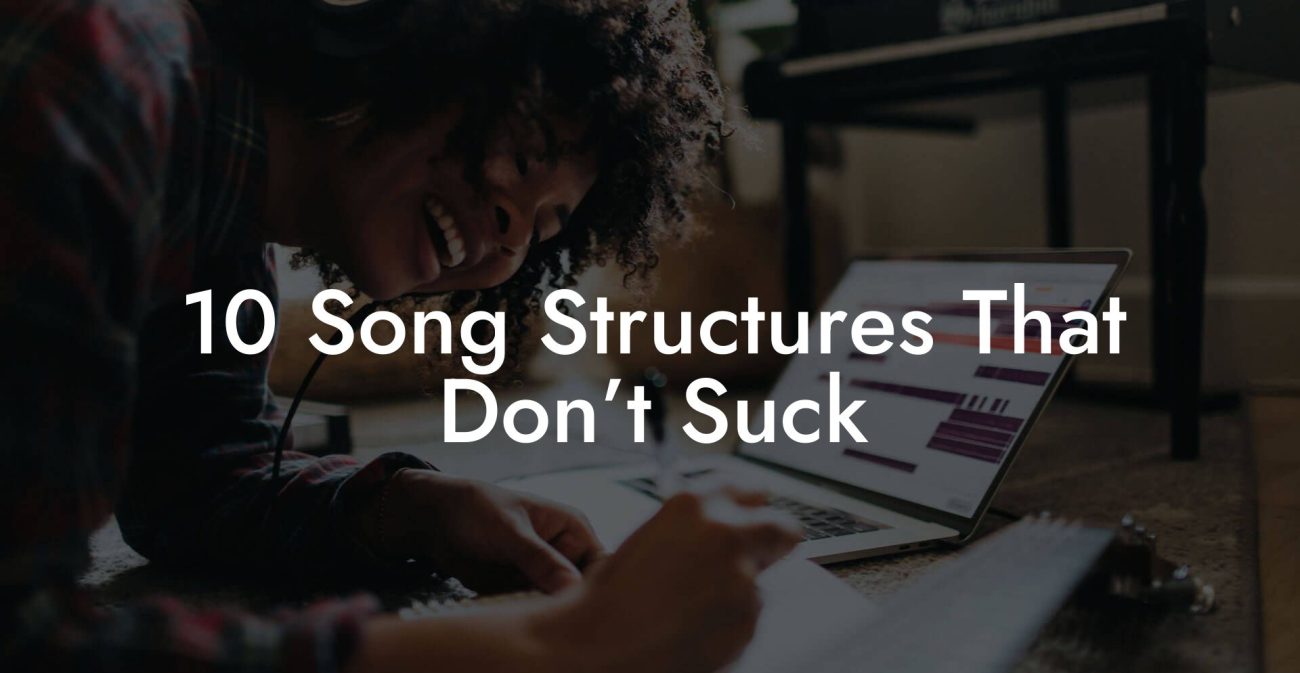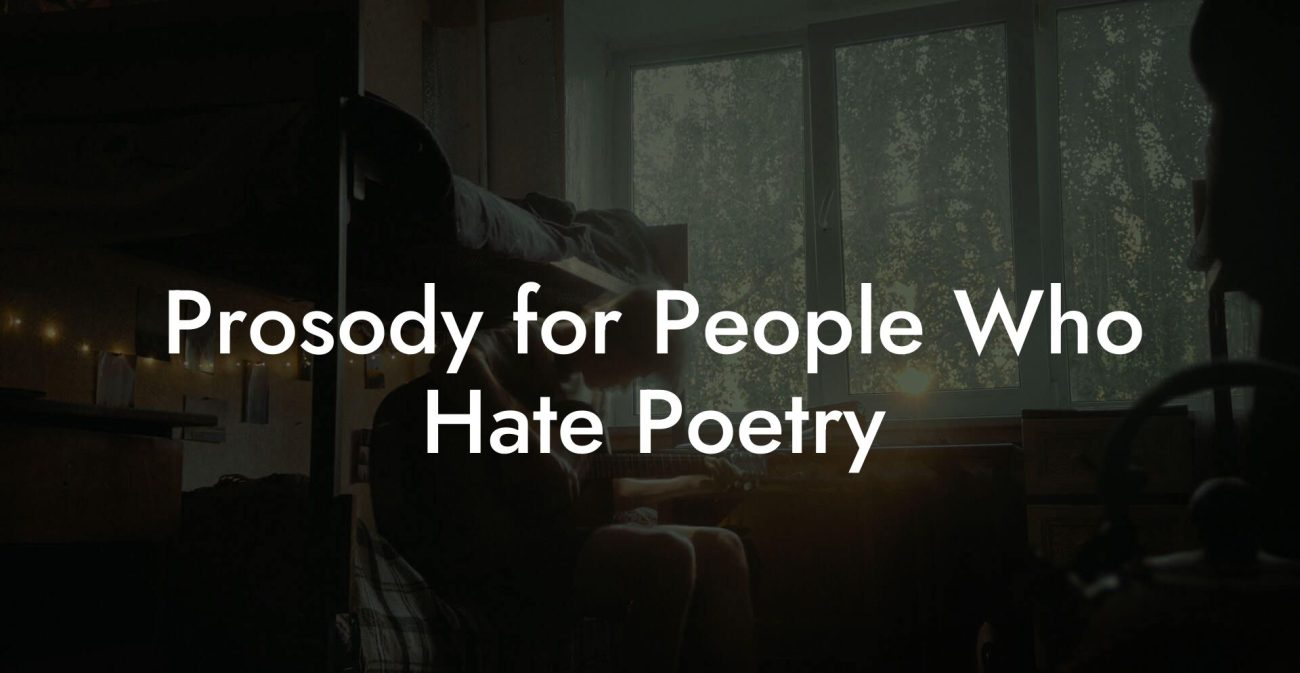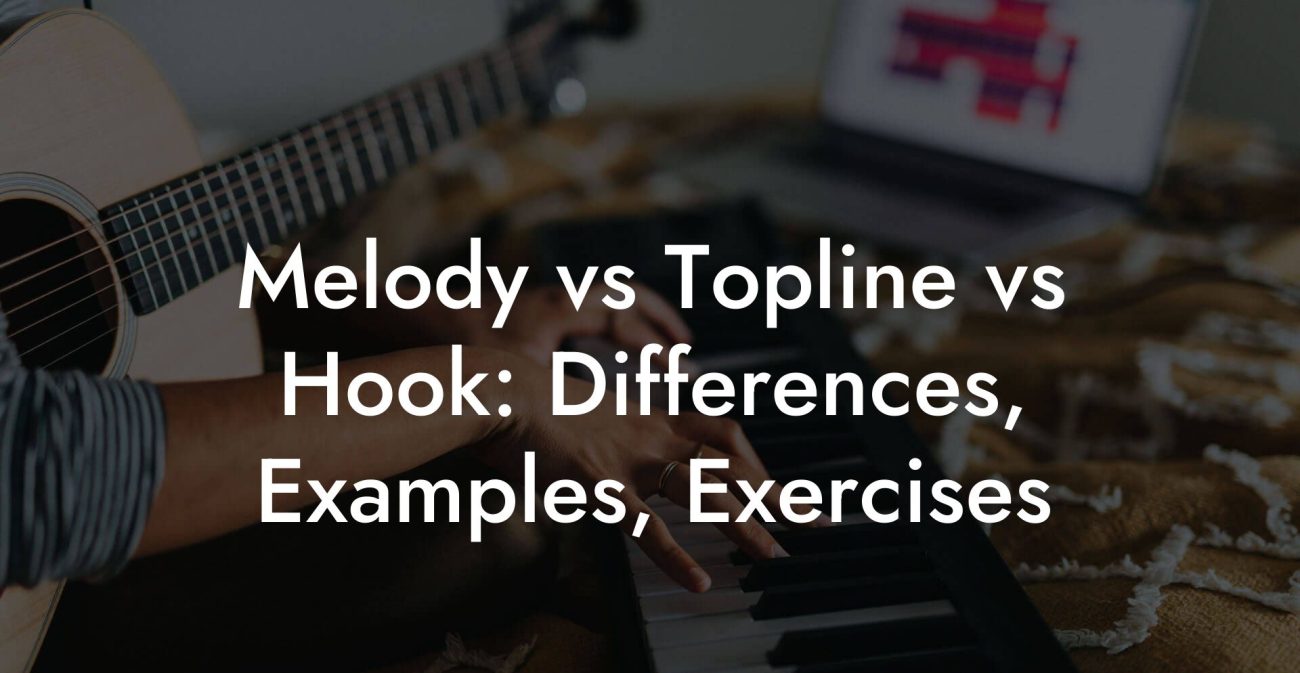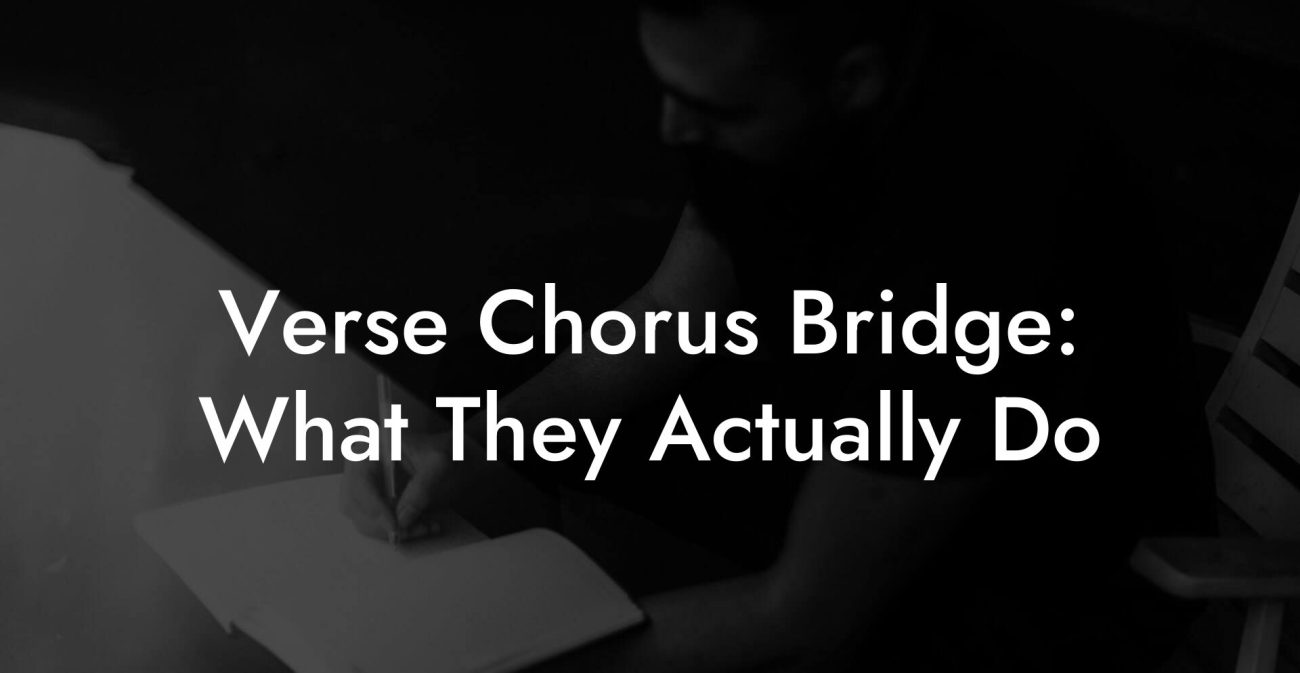Songwriting Advice
The Ultimate Beginner's Guide to Songwriting (No BS Version)
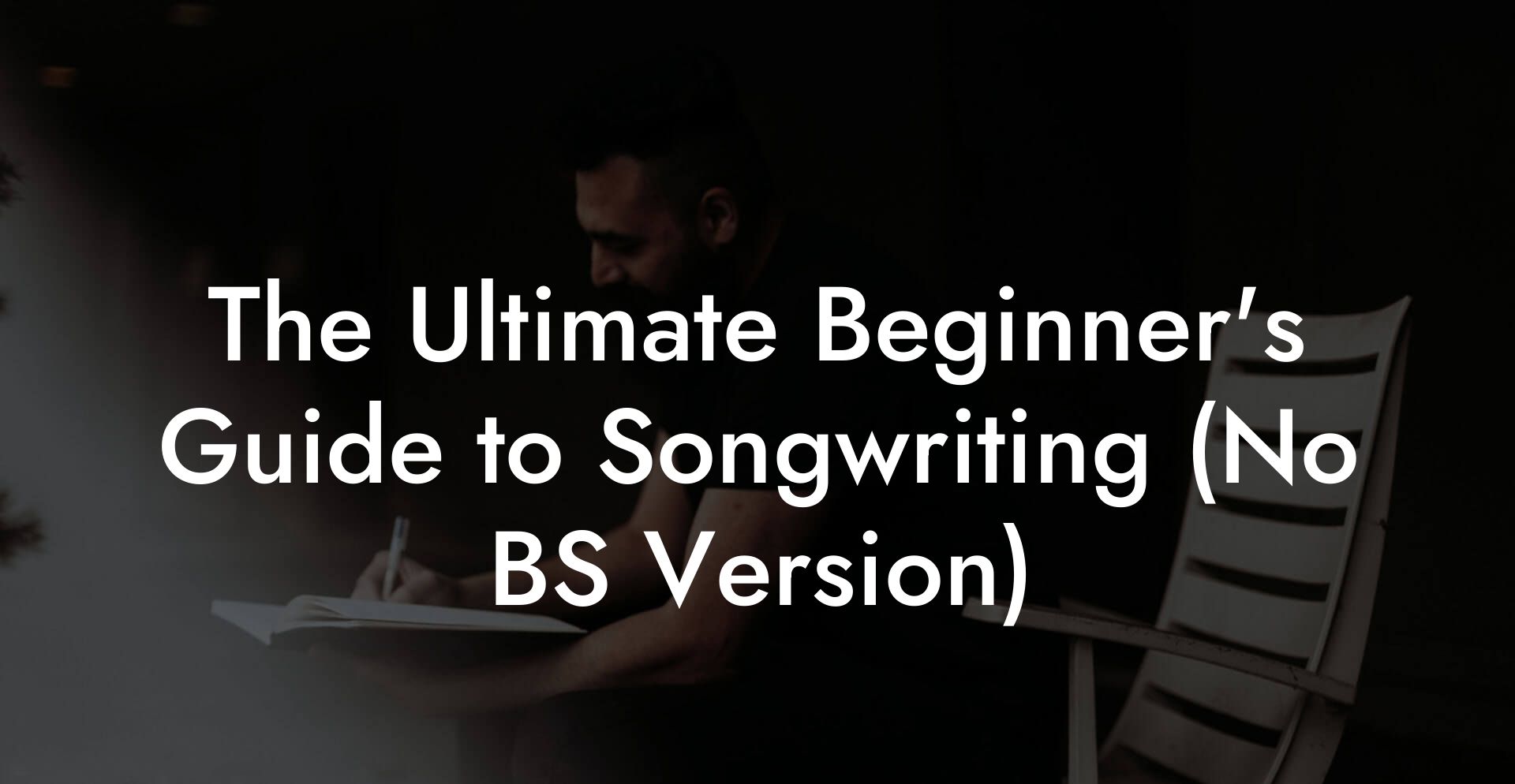
This is your songwriting bootcamp without the motivational poster energy. If you want to write songs that actually land with listeners and not just collect digital dust, you are in the right place. We are cutting through the mystic nonsense, the "wait for inspiration" trap, and the overcomplicated studio cult. This guide gives you a clear path from blank page to demo to something people can hum in the shower and tell their friends about.
Quick Interruption: Ever wondered how huge artists end up fighting for their own songs? The answer is in the fine print. Learn the lines that protect you. Own your masters. Keep royalties. Keep playing shows without moving back in with Mom. Find out more →
Quick Links to Useful Sections
- Why you can learn songwriting faster than you think
- Two truths to accept right now
- Core building blocks of a song
- Tools you need from day one
- 1. A DAW
- 2. A mic
- 3. A notebook or note app
- Music theory without the intimidation
- Writing lyrics that do not sound like a diary entry nobody asked for
- Start with the emotional promise
- Use concrete images
- Explain jargon and acronyms so your listeners do not need a translator
- Melody basics
- Melody rules that actually matter
- Structure templates you can steal
- Template A: Verse Pre Chorus Chorus Verse Pre Chorus Chorus Bridge Chorus
- Template B: Intro Chorus Verse Chorus Bridge Chorus
- Template C: Verse Chorus Verse Chorus Solo Chorus Outro
- Prosody explained like your music teacher is a stand up comic
- Rhyme and phrasing without sounding like a nursery rhyme
- Common rookie mistakes and how to demolish them
- Mistake 1: Too many ideas
- Mistake 2: Vague lyric salad
- Mistake 3: Chorus does not lift
- Mistake 4: Prosody friction
- Producing demos that sound intentional
- Demo checklist
- Copyright, credits, and how to not get screwed
- Copyright basics
- Publishing and PROs
- Mechanical royalties and streaming
- Collaboration: how to co write without drama
- Rules for smooth co writes
- How to finish songs faster
- Finish workflow you can steal
- Songwriting exercises that make you dangerous
- The object game
- The constraint challenge
- The title ladder
- The overwrite purge
- How to pitch songs and get placed
- Pitching basics
- Sync placements
- Real life scenarios and playbook
- How to get honest feedback without crying
- Questions to ask listeners
- Career basics for songwriters
- Multiple income streams
- Advanced but simple techniques that make songs feel professional
- Hook before complexity
- One signature sound
- Use space
- Keep learning and stay sane
- Daily practice template
- FAQ
Everything here is written for millennial and Gen Z creators who want fast results and zero awkwardness. Expect blunt humor, real life scenarios, step by step frameworks, and plain language explanations for every term and acronym. If a thing matters in the real world of songwriting we will explain it and show how to use it. No ego. No gatekeeping. Just tools and a plan you can use today.
Why you can learn songwriting faster than you think
Songwriting is a craft. Like skateboarding, the early spills are inevitable, but you can get good quickly by doing focused reps and stealing smart moves from people who already figured out what works. Most beginners waste time trying to be original instead of learning what listeners expect and then adding one bold personal detail. We will teach you the rules so you can bend them on purpose.
Two truths to accept right now
- Good songs solve one emotional problem cleanly. Pick one feeling and commit.
- Great hooks beat perfect chords. If a person can hum your chorus after one listen you are winning.
Core building blocks of a song
Every pop, rock, hip hop, indie, or bedroom hit is made from the same handful of parts. Know them by name and purpose.
- Hook , The earworm. Usually a chorus line or a short repeated phrase people sing back at parties. If your hook exists, the rest can be scaffolding.
- Verse , Tells the story. Think of a verse as a camera moving through a scene. Be specific and visual.
- Pre chorus , A short buildup that points to the hook without giving it away. It raises tension and expectation.
- Chorus , The emotional thesis. Simple language, obvious melody, repeatable.
- Bridge , A fresh angle or twist. Use it to shift perspective or surprise the listener.
- Outro , The leave taking. It can be a fade or one line repeated until the listener is ready to stop. Make it tidy.
Tools you need from day one
You do not need a million dollar studio. Start with three things and upgrade later.
1. A DAW
DAW stands for Digital Audio Workstation. It is the software where you record, edit, and produce songs. Common options are Ableton Live, Logic Pro, FL Studio, and Reaper. If you are on a budget, Reaper is cheap and powerful. If you love templates and nice plugins, Logic is a mainstream favorite. Pick one and learn the basics. You only need to know how to record a vocal and export an MP3 to start.
Real life scenario: You are in a coffee shop and a melody hits. Open your phone voice memo. Do not try to record pro. Capture the idea. Later drop that file into your DAW and build around it.
2. A mic
For demos a simple USB mic or a cheap condenser will do. You want clarity, not perfect tracking. If you sing and the mic makes you sound like soup, upgrade later. The point is to capture melody and rhythm so you can judge the song, not to go platinum tonight.
3. A notebook or note app
Lyric ideas die if you do not save them. Use a physical notebook or an app like Notes, Google Keep, or Evernote. Tag lines with a subject and date. That way you can assemble the best bits later.
Music theory without the intimidation
Music theory is a set of tools, not a personality. You only need a tiny toolkit to write real songs.
- Key , The home base. Choose a key that fits your voice.
- Scale , The set of notes that "work" in your key. Major sounds bright. Minor sounds moody.
- Chord , Three or more notes played together. Chords create the emotional floor under your melody.
- Progression , A sequence of chords. Common progressions are used because they sound satisfying. Learn a few and use them.
- BPM , Beats per minute. It tells you the tempo. 120 bpm is medium tempo. Rap and trap vary a lot. Electronic music often runs fast or slow depending on vibe.
Real life scenario: You hear a song you like and want to write something similar. Find the key and the four chord loop and you can write a melody over that loop within an hour. You learn faster by copying intentionally than by trying to invent new theory from scratch.
Writing lyrics that do not sound like a diary entry nobody asked for
Great lyrics manage two things at once. They are specific and they are universal. That means you give a tiny personal detail that feels true while the core emotion is something most people feel. Think of details as breadcrumbs that anchor big feelings.
Start with the emotional promise
One sentence. No poetry. Just the feeling your song will deliver. Example promises: I am over you but I keep your hoodie. Tonight I will not be the shy one. I want to leave but I am scared of silence. Write that sentence at the top of your page and return to it when you stray.
Use concrete images
Swap abstract words for objects and actions. Instead of I miss you write The second toothbrush stares from the glass. Sensory details create a movie in the listener's head.
Explain jargon and acronyms so your listeners do not need a translator
If you throw in an acronym like A&R do not assume everyone knows it. A&R stands for Artists and Repertoire. These are the people at a record label who find artists and decide what songs to sign. Real life scenario: You meet someone at a house party and they ask what you do. Saying I am a songwriter is good. Saying I shop demos to A R people without explaining could confuse them. Say A&R and then say people who scout artists. Keep it human.
Melody basics
Melody is the emotional vehicle. A simple melody that fits the voice and repeats wins over complicated melisma that only impresses on paper.
Melody rules that actually matter
- Make the chorus range higher than the verse. Small lift big feeling.
- Use a short repeated motif. Repetition is memory glue.
- Put the title on a long note or a strong beat. Let it breathe.
- Sing the melody out loud before you write words. If it feels awkward in the mouth change it.
Exercise: Vowel pass. Put on a two chord loop and sing on ah and oh for two minutes. Mark the bits you want to repeat. Then add words that match the rhythm of the chosen melody. This is how many hit hooks are born.
Structure templates you can steal
Start with a structure rather than inventing a new architectural style. Here are templates that work and why.
Template A: Verse Pre Chorus Chorus Verse Pre Chorus Chorus Bridge Chorus
Classic. Gives you space to build details in verses and a satisfying payoff in chorus. Use the bridge to flip the perspective or reveal a secret.
Template B: Intro Chorus Verse Chorus Bridge Chorus
Hook first. If you have an unmistakable chorus put it right at the top. This is great for streaming where attention is short.
Template C: Verse Chorus Verse Chorus Solo Chorus Outro
Straightforward and radio friendly. Use an instrumental solo for variation if you want a moment to breathe.
Prosody explained like your music teacher is a stand up comic
Prosody means aligning the natural stress of words with musical accents. If you stress the wrong word on the weak beat the lyric will feel off even if the words are brilliant.
Real life example: The line I love you more than coffee reads fine. If the melody puts more weight on the word coffee the sentence will sound like a caffeine confession. To fix it either move the stressed syllable or rewrite the line.
Rhyme and phrasing without sounding like a nursery rhyme
Rhyme is a tool not a prison. Modern songs often use partial rhymes and internal rhymes to avoid sounding predictable.
- Family rhyme means words that share similar vowel or consonant sounds but are not exact matches. Example chain: night, light, like, life.
- Internal rhyme happens inside a single line and adds musicality without forcing an end rhyme.
- Use perfect rhyme on the emotional turn. A perfect rhyme at the payoff can slingshot the line into the listener's memory.
Common rookie mistakes and how to demolish them
Everyone makes them. The goal is to spot them fast and fix them without falling in love with clunky lines.
Mistake 1: Too many ideas
Fix: Recenter on your emotional promise. Remove any line that does not push that idea forward.
Mistake 2: Vague lyric salad
Fix: Run the crime scene edit. Underline every abstract word and replace with a concrete detail.
Mistake 3: Chorus does not lift
Fix: Move chorus melody up a third, simplify language, lengthen the held note on the title.
Mistake 4: Prosody friction
Fix: Speak the line naturally. Mark stresses. Align them with beats or rewrite the melody.
Producing demos that sound intentional
Your demo does not need to be a final production. It does need to communicate the song. Think of your demo as the best possible elevator pitch for your song.
Demo checklist
- Clear vocal so people can hear the melody and lyric.
- Simple instrumental bed that supports the hook but does not compete.
- One signature sound or texture that gives the demo identity.
- Rough arrangement that shows where the hook hits and how sections flow.
Real life scenario: You are pitching a song to another artist. They will judge melody and lyrics first. If your demo has a muddy vocal they will guess the song is weak. Spend time getting the vocal clear. Use a little compression, a touch of reverb, and a clean EQ to remove muddiness. You do not need to over produce.
Copyright, credits, and how to not get screwed
Basic legal knowledge protects you. This is practical, not legal advice. For complex deals consult a lawyer.
Copyright basics
- Your song has two copyrights. One for the composition which covers melody and lyrics. One for the recording which covers a specific performance. Register your composition with your local copyright office. This gives you stronger legal standing.
- Split sheets are how collaborators agree on who owns what. A split sheet records percentages for each writer and performer. Use one before anyone makes money from the song.
Publishing and PROs
PRO stands for Performing Rights Organization. Examples are BMI, ASCAP, PRS. They collect performance royalties when your song is played on radio, streamed in public, or performed live. Sign up with a PRO early so you start collecting money when your songs are used.
Mechanical royalties and streaming
Mechanical royalties are paid when your song is reproduced. Streaming pays a combination of mechanical and performance royalties depending on territory and platform. If you cover someone else's song you may need a mechanical license. If a track uses a sample you must clear the original recording with the rights holders to avoid legal trouble.
Collaboration: how to co write without drama
Co writes are a huge part of modern songwriting. They speed learning and multiply opportunities. Here are rules that keep collaborations healthy and productive.
Rules for smooth co writes
- Agree splits at the end or write a provisional split sheet before handing over songs.
- Bring a clear idea to the session. Co writes are faster when someone arrives with a hook or a lyric concept.
- Be clear about roles. Some people are melody writers. Some are lyricists. Some produce arrangements. Respect each other.
- Record everything. If someone suggests a golden line you want it captured. Use your phone if nothing else is available.
How to finish songs faster
Beginner songwriters often start hundreds of half songs and finish none. Finish practice makes your instincts better.
Finish workflow you can steal
- Write the emotional promise. Title the song in one short line.
- Make a two chord loop and do a vowel pass to find a melody gesture.
- Write a chorus first and lock the hook. The chorus is the thesis.
- Draft one verse that supplies a detail the chorus needs. No more than 8 lines.
- Create a pre chorus that lifts into the chorus. Keep it short.
- Record a quick demo. Play the demo back and ask this question to one person. What line stuck with you? Then fix the song based on that answer only.
Songwriting exercises that make you dangerous
The object game
Pick an object in the room. Write four lines where the object does something unexpected. Ten minutes. This forces you into concrete imagery.
The constraint challenge
Write a chorus that does not use the word love. No cliches. Fifteen minutes. Constraints create better work than infinite freedom.
The title ladder
Write a title. Now write five alternate titles that mean the same idea with fewer syllables. Pick the one that sings the easiest.
The overwrite purge
Take a short chorus and remove any word that is not necessary. If the line still works remove another word. Repeat until the chorus is lean and sharp.
How to pitch songs and get placed
Placement means another artist records your song or a brand uses it in a sync. Both can change your career. The secret is relevance and relationships.
Pitching basics
- Understand the artist you pitch. If you are pitching a pop ballad to a trap artist you need a strong reason why they should record it.
- Have a solid demo. The best demos show vibe and melody clearly. No messy projects.
- Network without being slimy. Go to writer nights. Meet producers. Be the person who helps, not the person who only asks.
Sync placements
Sync means synchronization license. Brands, TV shows, and films pay to sync your recording with visuals. Practical tip: write a bank of short hooks and instrumentals that work as background music. Many syncs want simple clear moods and a strong instrumental hook that does not distract from dialogue.
Real life scenarios and playbook
Scenario 1. You have a melody but no words. Playbook: Do a vowel pass to lock melody. Write the emotional promise. Use the camera pass on each melodic phrase to create a visual line. Draft the chorus first and then fit verses around it.
Scenario 2. You have great lyrics but weak melody. Playbook: Put the lyrics aside and sing on vowels until you find a repeating motif. Then map your lyric stresses to the melody. If a word feels wrong change the lyric to fit the melody or the melody to fit the lyric. Both are valid.
Scenario 3. You are stuck in the middle of a song. Playbook: Cut to the end. Write an ending or bridge that offers a resolution. Sometimes forcing the end helps you rearrange the middle logically.
How to get honest feedback without crying
Feedback is only useful if it is specific. Ask people questions that can be answered clearly.
Questions to ask listeners
- What line stuck with you? This tells you the hook strength.
- Where did your attention drop? This tells you structural problems.
- What emotion did you feel in the chorus? If they say nothing you need to sharpen the promise.
Career basics for songwriters
You can be a performing songwriter, a writer for hire who places songs with others, or both. Build skills and income streams across multiple lanes.
Multiple income streams
- Publishing royalties from your songs when they are performed or streamed.
- Mechanical royalties from reproductions and streaming platforms.
- Sync fees from placements in TV, film, and advertising.
- Live performance fees if you perform your own songs.
- Teaching, sample packs, or selling stems if you produce music.
Practical tip: Register with a PRO, get your songs registered with your distributor when you release them, and keep split sheets for collaborations. Small administrative tasks protect income you might otherwise lose to confusion.
Advanced but simple techniques that make songs feel professional
Hook before complexity
Start with a melody hook. Complexity in production or lyric detail is decoration. If the hook is gone the song is gone.
One signature sound
Pick one sonic character for the track. A distinct arpeggio, a vocal chop, a guitar sound with personality. Let it appear like a character in a movie. This makes even a simple arrangement feel memorable.
Use space
Silence is a tool. A one beat pause before the chorus can make the listener lean forward. Do not fill every millisecond with noise.
Keep learning and stay sane
Songwriting is a craft that compounds. Daily reps beat sporadic perfectionism. Set small targets that are achievable and weekly targets that push you. Rest is part of the process. You will write worse on a tired day. Accept that and plan around it.
Daily practice template
- Warm up with ten minutes of singing on vowels.
- Do one five minute writing sprint on the object game.
- Refine one chorus line for twenty minutes. Use the overwrite purge.
- Record a three minute demo snippet and save it.
FAQ
Do I need to be able to play piano or guitar to be a songwriter
You do not need to be a virtuoso. Basic chords are enough to write complete songs. Many songwriters use voice memos and collaborators for chords. Learning a little piano or guitar will speed things up and give you independence. Think of playing as a tool not a barrier.
How do I come up with ideas
Ideas are everywhere. Use observation prompts. Listen to conversations and text messages. Pick a stranger's line you overhear and twist it into an emotional promise. Keep a running note app for sparks. The more material you collect the less pressure you feel to be inspired on demand.
How many songs should I write as a beginner
Quantity builds competence. Aim for one finished song every two weeks for six months. That gives you a body of work and the practice to understand what finishing means. Quantity without reflection is noise. After each song ask what improved from the last one and implement one targeted change on the next song.
What is the fastest way to write a chorus
Write a one line emotional promise. Make it singable. Place it on a long note or strong beat. Repeat it twice and add one twist line at the end. Keep the language everyday and specific. This gives you a chorus that is immediate and repeatable.
Should I write lyrics or music first
There is no absolute rule. Many writers prefer melody first because it gives natural rhythm to lyrics. Some prefer lyrics first when the concept is the driver. Try both and pick the workflow that makes you finish more songs. Being flexible is a strength.
How do I handle writer's block
Limit the scope. Set a ten minute timer and write exactly three lines about a tiny detail. Use constraints and go low pressure. Change the environment. Walk and record voice memos. Sometimes the simplest action loosens the brain.
What is a split sheet and why is it important
A split sheet records who wrote what percentage of a song. If you collaborate a split sheet prevents future disputes and ensures royalties are paid to the right people. Do it before release and get signatures. It is boring paperwork that saves relationships and money.
How do I know if a song is good enough
If an honest listeners remembers a line or the melody after a single listen you have something. If several trusted listeners react emotionally to the chorus you are close. Use specific feedback questions and compare multiple demos. Ultimately you ship the song that does the job you set in your emotional promise.

